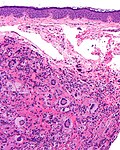Difference between revisions of "Juvenile xanthogranuloma"
Jump to navigation
Jump to search
(+cat.) |
(make into own article) |
||
| Line 1: | Line 1: | ||
'''Juvenile xanthogranuloma''', abbreviated '''JXG''', is a relatively common distinctive diagnosis in dermatopathology. It is also known as '''nevoxanthoendothelioma'''. In adults, it is called ''adult xanthogranuloma''.<ref name=Ref_Derm622>{{Ref Derm|622}}</ref> | |||
==General== | |||
*Usually in children and infants, may be in adults.<ref name=Ref_Derm622>{{Ref Derm|622}}</ref> | |||
*Most common form of non–Langerhans cell histiocytosis.<ref name=emed_jxg>URL: [http://emedicine.medscape.com/article/1111629-diagnosis http://emedicine.medscape.com/article/1111629-diagnosis]. Accessed on: 3 February 2011.</ref> | |||
*Can rarely be found in the brain.<ref>URL: [http://path.upmc.edu/cases/case245/dx.html http://path.upmc.edu/cases/case245/dx.html]. Accessed on: 13 January 2012.</ref> | |||
==Microscopic== | |||
Features:<ref name=emed_jxg>URL: [http://emedicine.medscape.com/article/1111629-diagnosis http://emedicine.medscape.com/article/1111629-diagnosis]. Accessed on: 3 February 2011.</ref> | |||
*Dermal histiocytes: | |||
**Abundant cytoplasm - may not be xanthomatous/foam cells. | |||
*+/-Touton [[giant cell]] - '''key feature'''. | |||
**Large multi-nucleated cells where nuclei are distributed at the cell periphery. | |||
DDx: | |||
*[[Langerhans cell histiocytosis]]. | |||
*[[Spitz nevus]] - uncommon; reported to have Touton cells.<ref name=pmid18312437>{{Cite journal | last1 = Guitart | first1 = J. | last2 = Gerami | first2 = P. | title = Touton-like giant cells in a Spitz's nevus. | journal = J Cutan Pathol | volume = 35 | issue = 7 | pages = 694-5 | month = Jul | year = 2008 | doi = 10.1111/j.1600-0560.2007.00877.x | PMID = 18312437 }}</ref> | |||
*[[Dermatofibroma]], aneurysmal - has Touton [[giant cell]]s and hemosiderin deposition. | |||
Notes: | |||
*Must prove they are non-Langerhans cell histiocytes, esp. if no Touton giant cells. | |||
===Images=== | |||
<gallery> | |||
Image:Juvenile_xanthogranuloma_-_intermed_mag.jpg | Juvenile xanthogranuloma - intermed. mag. (WC) | |||
Image:Juvenile_xanthogranuloma_-_very_high_mag.jpg | Touton giant cells in a juvenile xanthogranuloma - very high mag. (WC) | |||
</gallery> | |||
===IHC=== | |||
Features:<ref name=emed_jxg/> | |||
*Langerhans cell markers: CD1a, CD207 -- both should be negative. | |||
**If Touton giant cells are absent -- this is essential. | |||
*Histiocyte markers: CD68, CD163 -- both should be positive. | |||
*Vimentin +ve. | |||
Other markers:<ref name=pmid11285404>{{Cite journal | last1 = Kraus | first1 = MD. | last2 = Haley | first2 = JC. | last3 = Ruiz | first3 = R. | last4 = Essary | first4 = L. | last5 = Moran | first5 = CA. | last6 = Fletcher | first6 = CD. | title = Juvenile xanthogranuloma: an immunophenotypic study with a reappraisal of histogenesis. | journal = Am J Dermatopathol | volume = 23 | issue = 2 | pages = 104-11 | month = Apr | year = 2001 | doi = | PMID = 11285404 }}</ref> | |||
*CD4 +ve (21 of 27 cases). | |||
*CD45 +ve (25 of 27 cases). | |||
*Factor XIIIa +ve (25 of 27 cases). | |||
Negatives:<ref name=pmid9790615>{{cite journal |author=Thomas DB, Sidler AK, Huston BM |title=Radiological case of the month. Juvenile xanthogranuloma |journal=Arch Pediatr Adolesc Med |volume=152 |issue=10 |pages=1029–30 |year=1998 |month=October |pmid=9790615 |doi= |url=http://archpedi.ama-assn.org/cgi/content/full/152/10/1029}}</ref> | |||
*Muscle markers: actin, desmin. | |||
*Others: S100, factor VIII, cytokeratins. | |||
==Sign out== | |||
<pre> | |||
SKIN LESION, CHIN, BIOPSY: | |||
- JUVENILE XANTHOGRANULOMA. | |||
</pre> | |||
==See also== | |||
*[[Dermatopathology]]. | |||
*[[Pediatric pathology]]. | |||
==References== | |||
{{Reflist|2}} | |||
[[Category:Dermatopathology]] | |||
[[Category:Diagnosis]] | [[Category:Diagnosis]] | ||
Revision as of 16:06, 6 June 2013
Juvenile xanthogranuloma, abbreviated JXG, is a relatively common distinctive diagnosis in dermatopathology. It is also known as nevoxanthoendothelioma. In adults, it is called adult xanthogranuloma.[1]
General
- Usually in children and infants, may be in adults.[1]
- Most common form of non–Langerhans cell histiocytosis.[2]
- Can rarely be found in the brain.[3]
Microscopic
Features:[2]
- Dermal histiocytes:
- Abundant cytoplasm - may not be xanthomatous/foam cells.
- +/-Touton giant cell - key feature.
- Large multi-nucleated cells where nuclei are distributed at the cell periphery.
DDx:
- Langerhans cell histiocytosis.
- Spitz nevus - uncommon; reported to have Touton cells.[4]
- Dermatofibroma, aneurysmal - has Touton giant cells and hemosiderin deposition.
Notes:
- Must prove they are non-Langerhans cell histiocytes, esp. if no Touton giant cells.
Images
IHC
Features:[2]
- Langerhans cell markers: CD1a, CD207 -- both should be negative.
- If Touton giant cells are absent -- this is essential.
- Histiocyte markers: CD68, CD163 -- both should be positive.
- Vimentin +ve.
Other markers:[5]
- CD4 +ve (21 of 27 cases).
- CD45 +ve (25 of 27 cases).
- Factor XIIIa +ve (25 of 27 cases).
Negatives:[6]
- Muscle markers: actin, desmin.
- Others: S100, factor VIII, cytokeratins.
Sign out
SKIN LESION, CHIN, BIOPSY: - JUVENILE XANTHOGRANULOMA.
See also
References
- ↑ 1.0 1.1 Busam, Klaus J. (2009). Dermatopathology: A Volume in the Foundations in Diagnostic Pathology Series (1st ed.). Saunders. pp. 622. ISBN 978-0443066542.
- ↑ 2.0 2.1 2.2 URL: http://emedicine.medscape.com/article/1111629-diagnosis. Accessed on: 3 February 2011.
- ↑ URL: http://path.upmc.edu/cases/case245/dx.html. Accessed on: 13 January 2012.
- ↑ Guitart, J.; Gerami, P. (Jul 2008). "Touton-like giant cells in a Spitz's nevus.". J Cutan Pathol 35 (7): 694-5. doi:10.1111/j.1600-0560.2007.00877.x. PMID 18312437.
- ↑ Kraus, MD.; Haley, JC.; Ruiz, R.; Essary, L.; Moran, CA.; Fletcher, CD. (Apr 2001). "Juvenile xanthogranuloma: an immunophenotypic study with a reappraisal of histogenesis.". Am J Dermatopathol 23 (2): 104-11. PMID 11285404.
- ↑ Thomas DB, Sidler AK, Huston BM (October 1998). "Radiological case of the month. Juvenile xanthogranuloma". Arch Pediatr Adolesc Med 152 (10): 1029–30. PMID 9790615. http://archpedi.ama-assn.org/cgi/content/full/152/10/1029.

